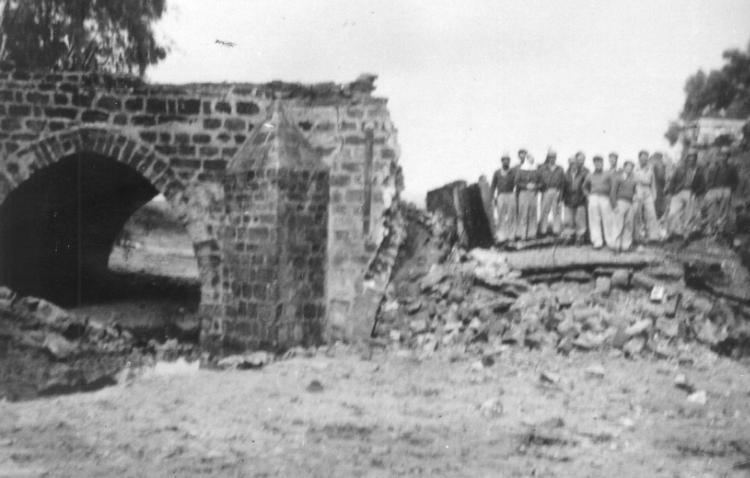Arabic دير سنيد Palestine grid 107/109 Local time Saturday 6:14 PM | Population 730 (1945) | |
 | ||
Name meaning "Monastery of the declivity" Also spelled Deir Suneid, Deir Sineid Weather 16°C, Wind N at 11 km/h, 70% Humidity | ||
Tracing all that renmain of the destroyec village of dayr sunayd
Dayr Sunayd (Arabic: دير سنيد) was a Palestinian Arab village in the Gaza Subdistrict, located 12 kilometers (7.5 mi) northeast of Gaza. Situated at an elevation of 50 meters (160 ft) along the southern coastal plain of Palestine, Deir Sunayd had a total land area of 6,081 dunams. Prior to its depopulation during the 1948 Arab–Israeli War, it had 730 inhabitants in 1945.
Contents
- Tracing all that renmain of the destroyec village of dayr sunayd
- History
- British Mandate era
- 1948 War and aftermath
- References
History
The first part of its name "Dayr" is Arabic for "Monastery", suggesting that it was once the site of a monastic order or a Christian population possibly resided there at one point of time. "Sunayd" was the name of an Arab tribe in the area. Under the Ottoman Empire, in 1596, Dayr Sunayd laid in the nahiya of Gaza, part of the Sanjak of Gaza. With a population of 66, it paid taxes on wheat, barley, fruit, beehives and goats. The village appeared under the name of Deir Esni on the map that Pierre Jacotin compiled in 1799.
In 1838, Edward Robinson noted it under the name of Deir Esneid, while in 1863, French explorer Victor Guérin found the village, which he called Deir Essneid, to have 150 inhabitants. Its gardens were mainly planted with figs.
In the late 19th century, Dayr Sunayd was a moderate-sized village that was rectangular in shape, split into four quadrants by two roads that crossed at right in angles. It had adobe brick houses, eight wells, gardens, a pond, and at the center of the village was a mosque.
British Mandate era
In the 1922 census of Palestine, conducted by the British Mandate authorities, Dair Sunait had a population of 356 inhabitants, all Muslims, increasing in the 1931 census to 475, still all Muslim, in 103 houses.
By the end of the British Mandate period, Dayr Sunayd had expanded west toward the coastal highway. A school was opened in 1945 with an enrollment of 63 students and a number of small shops were opened there as well. Agriculture was the primary source of income for most residents, followed by commerce.
In 1945 Dayr Sunayd had a population of 730, all Muslims, with a total of 6,081 dunams of land, according to an official land and population survey. Of this, 158 dunams were used for citrus and bananas, 512 dunams were for plantations and irrigable land, 4,863 for cereals, while 13 dunams were built-up land.
1948 War and aftermath
The date on which Dayr Sunayd was captured during the 1948 Arab-Israeli War cannot be specified, but the village was probably seized by Israeli forces in late October or early November 1948. It had come under aerial bombardment in Operation Yoav on October 15–16, according to Israeli historian Benny Morris. The New York Times reported that it was "pummeled" again on October 21.
Dayr Sunayd also witnessed fighting in the early stages if the war, as Egyptian and Jewish forces battled for control of the village and the nearby town of Yad Mordechai shortly after May 15, 1948. The late president of Egypt, Gamal Abdel Nasser said that when spent the night at the Gaza Military Hospital, "the beds around me were filled with our wounded from the battle of Dayr Sunayd, which was still in progress". Abdel Nasser was critical of the Egyptian command's strategy at the battle, but nonetheless, it ended in an Egyptian victory "after heavy sacrifices and in spite of all the difficulties our forces encountered." Abdel Nasser's colleague Abdel Hakim Amer participated in the battle.
There are no Jewish towns on village lands. According to Palestinian historian Walid Khalidi, the remains of Dayr Sunayd consisted in 1992 of "A railroad bridge, unused segments of track, and three of the train station's buildings are all that remain of Dayr Sunayd. The stone bridge is built astride a wadi and passes over four wide, round-arched culverts. The station's buildings are deserted and in a state of deterioration."
